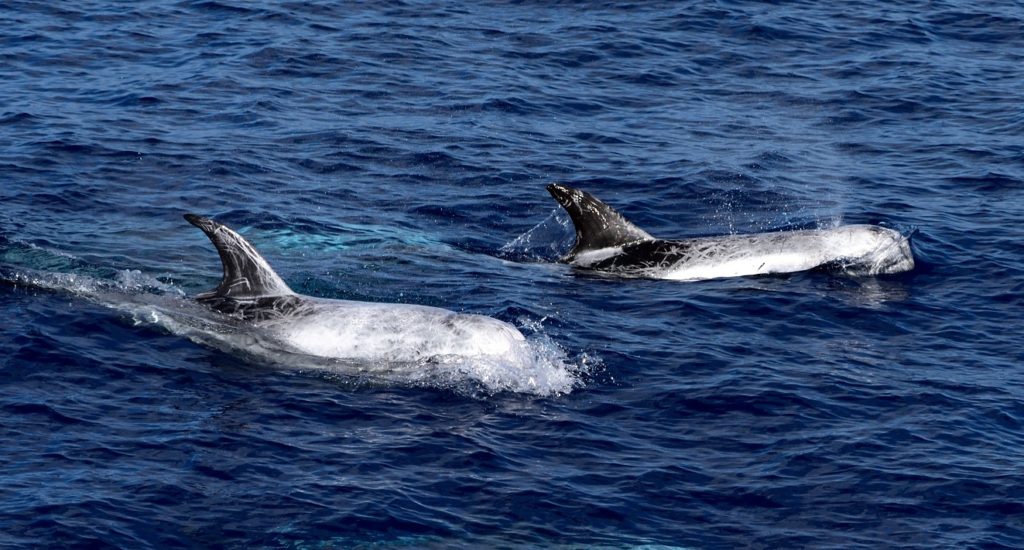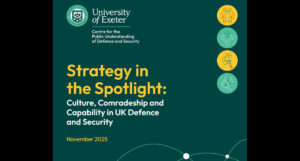Endangered whales live in area earmarked for gas exploration

Risso's dolphins. Credit Leonidas Karantzas/Greenpeace
Endangered whales and dolphins live year-round in an area of the Mediterranean earmarked for oil and gas exploration, new research shows.
Various cetacean species are known to inhabit the Hellenic Trench off Greece in the summer, but until now little has been known about their winter whereabouts.
This lack of information has been used to justify seismic surveys (which may harm whales and dolphins) in winter.
The new study found that at least four species – including the regionally endangered sperm whale – live in the deep waters of the Hellenic Trench in both summer and winter.
The research was carried out in 2021-22 by the Greenpeace Research Laboratories, University of Exeter, Greenpeace Greece and the Pelagos Cetacean Research Institute.
“The Mediterranean is one of the busiest seas on the planet, and whales and dolphins are already threatened by ship strikes, overfishing, bycatch (accidental catching), pollution with chemicals and plastics, and climate change,” said Dr Kirsten Thompson.
“Noise is also a key threat. Certain whale species, for example the Cuvier’s beaked whales, are known to be particularly vulnerable to human-made noise, which comes from sources including ship engines, military sonar and ‘air guns’ used to survey for oil and gas.
“These combined threats could affect populations of whales and dolphins that rely on the Hellenic Trench as key habitat.
“The shallower waters of the Hellenic Trench have been designated as an Important Marine Mammal Area. Based on our findings, it is clear that seismic surveys and oil and gas extraction across the Trench would be completely at odds with conservation.”
Co-author Dr Alexandros Frantzis, Scientific Director of Pelagos Cetacean Research Institute, said: “We have already shown that ship-strikes alone will drive the eastern Mediterranean population of sperm whales to extinction in a few decades, if no measures (shipping lanes and/or creation of Areas to be Avoided) are taken along the Hellenic Trench.
“For nine years, we have been trying to convince the Greek authorities to address this problem in collaboration with the International Maritime Organisation, with no concrete results.
“On the other hand, the local population of Cuvier’s beaked whales, after decades of repeated mass strandings due to military sonar use, are declining as well as the striped dolphins that inhabit the Hellenic Trench.
“Seismic surveys and gas and oil exploration in the area will be the ‘coup de grace’ for the local cetacean populations if added to the already existing anthropogenic pressures and threats.”
Kostis Grimanis, of Greenpeace Greece, added: “This important research demonstrates clearly that endangered whales and dolphins live year-round in an area of the Mediterranean of huge ecological importance.
“The choice to follow through with oil and gas drilling in those waters will not only be detrimental to our collective fight against the climate crisis but also to our collective efforts to conserve and protect those iconic species of marine biodiversity.”
The researchers used two Greenpeace vessels to carry out visual and acoustic surveys of large areas of the Hellenic Trench, including two blocks that are earmarked for seismic surveys and potential oil and gas exploration (west Crete and south-west Crete).
The area may also be affected by a proposed new gas pipeline called EastMed, which would connect eastern Mediterranean gas reserves to Greece.
Using sightings and computer analysis of audio recordings, the research team confirmed the presence of endangered sperm whales, Cuvier’s beaked whales (classified as “vulnerable” in the Mediterranean), Risso’s dolphins, striped dolphins and rough-toothed dolphins.
They confirmed a further 224 recordings of unidentified dolphins (several dolphins have similar vocalisations, so it is not always possible to distinguish between them).
The paper, published in the journal Endangered Species Research, is entitled: “Summer and winter surveys of deep waters of the Hellenic Trench, Greece, provide insights into the spatial and temporal distribution of odontocetes.”



